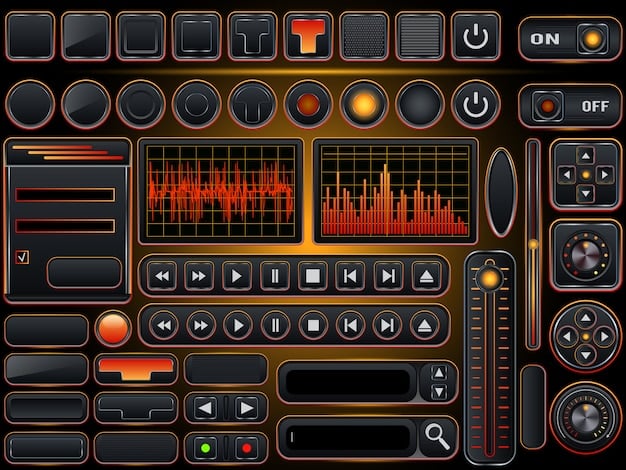Sound Design for Games: Enhance Immersion with Audio

Sound design in games is the art and science of crafting auditory experiences that significantly enhance player immersion, communicate crucial information, and evoke emotional responses, transcending mere background noise to become an integral narrative and gameplay element.
In the expansive realm of interactive entertainment, visuals often command the spotlight, yet it’s the unseen, unheard, and deeply felt elements that truly glue players to their screens. Among these, professional Sound Design for Games: Enhance Immersion with Audio stands as a colossal, often-underestimated pillar, transforming simple gameplay into an unforgettable journey.
The Crucial Role of Audio in Game Immersion
The sounds we perceive in a game create the illusion of reality, drawing players deeper into virtual worlds. Without a meticulously crafted soundscape, even the most visually stunning games can feel hollow, disconnected. Sound acts as a direct conduit to the player’s emotions, providing immediate feedback and enhancing their sense of presence.
From the satisfying click of a weapon reload to the ominous creak of a distant door, every audio cue contributes to the overall immersion. These subtle, yet powerful, elements inform the player about their surroundings, immediate threats, and even the emotional state of characters. The brain processes sound with incredible speed, often before visual information, making it a critical tool for conveying urgency and danger.
Beyond Mere Background Noise
Sound design in games extends far beyond simply adding background music or generic sound effects. It’s a complex discipline that involves the careful selection, creation, and manipulation of audio elements to serve specific gameplay and narrative functions. A skilled sound designer understands how to sculpt sonic experiences that resonate with players on a visceral level, transforming the seemingly mundane into the extraordinarily memorable.
- Emotional Resonance: Audio can evoke powerful emotions, such as fear from a sudden scream or triumph from a rousing fanfare.
- Spatial Awareness: Positional audio helps players locate enemies, understand the direction of attacks, and perceive the size and scope of environments.
- Gameplay Feedback: Every action, from picking up an item to landing a critical hit, can be reinforced and made more satisfying through distinct sound effects.
- Narrative Enhancement: Sounds can tell stories, hint at lore, or characterize environments, enriching the game’s overall narrative fabric.
Consider the silence often used in horror games, deliberately broken by a sharp, unexpected noise. This deliberate manipulation of sound and its absence dramatically heightens tension and fear. Similarly, the harmonious blend of environmental sounds, character dialogue, and musical scores can transport a player to a bustling city, a serene forest, or a war-torn battlefield.
Ultimately, a game’s audio experience is a powerful, often subconscious, driver of player engagement. When executed well, it seamlessly integrates with other game elements, creating a cohesive and believable world that players are eager to explore and return to.
Key Principles of Effective Game Sound Design
Achieving truly effective sound design requires adherence to several core principles that guide the creation and implementation of auditory elements. These principles ensure that sound not only enhances immersion but also serves the game’s functional requirements and artistic vision.
At its heart, effective game sound design is about providing clear, concise, and compelling auditory information without overwhelming the player. It’s a delicate balance between realism and artistic license, ensuring that sounds feel authentic within the game’s context while also serving specific gameplay purposes.
Clarity and Cohesion
One of the foremost principles is clarity. Players need to quickly and unambiguously understand what a sound signifies. A gunshot should clearly sound like a gunshot, and a monster growl should distinguish itself from ambient environmental noise. Ambiguity in sound can lead to confusion and frustration, detracting from the player’s experience.
- Priority and Layering: Not all sounds are equally important at a given moment. Sound designers prioritize critical sounds (like an incoming attack) over less crucial ones (like distant ambient chatter) through techniques like dynamic mixing and ducking.
- Consistency: Sounds should remain consistent within the game’s established world. If a character’s footsteps sound heavy on one surface, they shouldn’t suddenly sound light on the same surface elsewhere, unless there’s a narrative reason.
- Appropriateness: Sounds must fit the game’s aesthetic and tone. A gritty, realistic war game will require different sound design approaches than a whimsical, cartoon-style platformer.
Beyond individual clarity, overall cohesion in the soundscape is vital. All audio elements – music, sound effects, and voice acting – should work in harmony, supporting the game’s themes and atmosphere rather than clashing or competing with each other. This often involves careful attention to frequency ranges, volume levels, and stereo imaging to create a rich and balanced sonic environment.
Dynamic and Responsive Audio
Unlike linear media, games are interactive, and their soundscapes must reflect this interactivity. Dynamic audio systems react to player actions, events, and environmental changes, making the world feel alive and responsive. This responsiveness is a cornerstone of immersion, as it reinforces the player’s agency within the virtual world.
Consider how footsteps change based on the surface a character walks on – gravel, wood, water, or metal. This immediate auditory feedback validates the physics and material properties of the game world. Similarly, music might intensify as a player enters combat, or environmental sounds might shift as weather conditions change.
Effective dynamic audio often utilizes parameter-driven systems, where variables in the game engine (like player health, proximity to enemy, or environmental state) directly influence audio parameters like volume, pitch, or even the selection of sound files. This creates a seamlessly evolving auditory experience that adapts to the player’s journey.
Tools and Technologies in Modern Game Audio
The field of game sound design has been revolutionized by advancements in technology, offering designers powerful tools to craft incredibly sophisticated and immersive audio experiences. These tools range from digital audio workstations (DAWs) for creating and editing sounds to dedicated middleware solutions for integrating and managing audio within game engines.
Understanding the capabilities of these technologies is crucial for any aspiring sound designer, as they dictate the scope and quality of what can be achieved. Modern workflows emphasize efficiency, flexibility, and creative freedom, allowing designers to iterate quickly and experiment with complex sonic ideas.
Digital Audio Workstations (DAWs)
DAWs are the central hubs for creating, manipulating, and mixing audio assets. They provide a comprehensive suite of tools for recording, editing, processing, and mastering sound. Popular DAWs used in game audio include:
- Pro Tools: Industry-standard for professional audio production, known for its robust editing and mixing capabilities.
- Reaper: A highly customizable and affordable DAW, popular among indie developers and freelancers for its flexibility.
- Ableton Live: Favored for its intuitive interface, real-time performance capabilities, and strong integration with MIDI and VST instruments.
- Logic Pro X (Mac only): A powerful, user-friendly DAW with a vast library of sounds and instruments, excellent for music composition and sound design.
Within these DAWs, sound designers utilize various plugins and effects processors—such as equalizers, compressors, reverbs, and delays—to sculpt and refine their sounds. The goal is to make each sound distinctive, polished, and ready for integration into the game engine.

Audio Middleware Solutions
While DAWs are for creating raw audio assets, middleware handles their integration and management within the game engine. Middleware acts as a bridge, allowing sound designers to implement complex audio behaviors without extensive programming. They provide powerful features like:
- FMOD Studio: A leading audio middleware, widely used for its robust event-based system, allowing designers to create intricate audio behaviors that react dynamically to gameplay.
- Wwise (Audiokinetic): Another industry giant, known for its extensive profiling and debugging tools, flexible routing, and comprehensive feature set for adaptive audio.
These middleware solutions enable designers to:
- Implement Adaptive Music: Music that changes tempo, intensity, or instrumentation based on gameplay events.
- Create Environmental Ambience: Complex soundscapes that transition smoothly between different environments.
- Manage Voice Lines: Organize and trigger character dialogue, often with localization support.
- Design Dynamic Sound FX: Generate variations of sound effects (e.g., footstep sounds changing based on surface, impact sounds changing based on material).
- Utilize Positional Audio: Place sounds accurately in 3D space, taking into account distance, occlusion, and reflections.
The combination of powerful DAWs and flexible audio middleware empowers sound designers to push the boundaries of what’s possible, crafting intricate and reactive soundscapes that significantly elevate the player’s experience. These tools streamline workflows, allowing designers to focus on creative expression rather than technical roadblocks.
The Sound Design Process: From Concept to Implementation
The creation of a game’s soundscape is a methodical process, evolving from initial conceptualization to final implementation and refinement. It’s an iterative journey requiring close collaboration with other development teams, particularly level designers, programmers, and narrative writers.
Understanding this workflow is essential for anyone involved in game development, as it highlights how sound design integrates with the broader project and contributes to the overall success of the game. It’s a continuous cycle of creation, testing, feedback, and refinement.
Conceptualization and Pre-Production
The sound design process typically begins early in pre-production, alongside other creative departments. This phase involves:
- Establishing the Audio Vision: Defining the overall sonic aesthetic and emotional tone of the game, often inspired by concept art, lore, and core gameplay mechanics.
- Creating an Audio Style Guide: A document outlining the desired sound palette, themes, and specific audio rules. This ensures consistency across different sound designers and stages of development.
- Reference Gathering: Collecting examples of inspiring sounds from films, other games, and real-world recordings. This helps solidify the desired sonic identity.
- Prototyping: Creating early sound prototypes for key gameplay moments to test concepts and gather feedback from the team.
During this stage, sound designers work closely with game directors and producers to ensure the audio aligns with the game’s overarching vision. Early involvement helps avoid costly rework later in the development cycle by identifying potential challenges and opportunities for audio enhancement.
Production: Creation, Editing, and Mixing
With the audio vision established, the production phase begins. This is where the actual sounds are created and refined. It involves:
- Field Recording and Foley: Capturing real-world sounds in various environments or creating specific sounds (Foley) for characters and objects in a studio. This provides authentic source material.
- Synthesizing Sounds: Using synthesizers and digital sound generators to create unique, often abstract, sounds that cannot be found in the real world.
- Sound Editing: Cleaning, shaping, and manipulating raw audio files within a DAW. This includes noise reduction, normalization, cutting, splicing, and applying effects to achieve the desired texture and clarity.
- Mixing: Balancing the levels of individual sound elements (dialogue, music, sound effects) to ensure they work harmoniously and don’t mask important audio cues. This also involves spatialization and dynamic processing.
Each sound asset undergoes rigorous refinement to ensure it meets the technical and artistic standards set during pre-production. This phase is characterized by iteration, with sounds often being tweaked multiple times based on internal testing and feedback.
Implementation and Post-Production
Implementation is where the magic happens, bringing the meticulously crafted sounds into the game engine using middleware. This involves:
- Event Creation: Defining how and when sounds will be triggered in the game (e.g., on a character’s footstep, when an enemy takes damage, during a cinematic).
- Parameter Integration: Linking sound parameters (like volume, pitch, or reverb) to game variables, allowing for dynamic and adaptive audio.
- Positional Audio Setup: Ensuring sounds emanate from the correct locations in the 3D environment and react realistically to player movement and camera angles.
- Bug Fixing and Optimization: Identifying and resolving any audio issues, such as missing sounds, incorrect triggers, or performance bottlenecks. Optimizing audio files for size and memory consumption.
The post-production phase involves final mixing, mastering, and quality assurance. This often includes playtesting with a focus on audio, gathering feedback, and making final adjustments to ensure the soundscape is polished and fully integrated into the game’s overall experience.
Challenges and Best Practices in Game Sound Design
While the potential for immersive audio in games is immense, sound designers face a unique set of challenges, from technical limitations to creative complexities. Navigating these obstacles requires a combination of technical prowess, artistic vision, and adherence to established best practices.
Understanding these challenges is as important as mastering the tools, as it prepares designers for the realities of game development. Best practices, in turn, provide a roadmap for consistent quality and efficiency, ensuring that audio contributions are consistently valuable.
Common Challenges
One primary challenge is Resource Management. Games are complex, and audio often competes for precious CPU, memory, and disk space with graphics, AI, and physics. Sound designers must work efficiently, optimizing audio files without compromising quality. This can involve using compressed formats, streamable assets, and intelligent sound banks.
Another significant hurdle is Dynamic Environments and Player Agency. Unlike linear media, where sound can be precisely timed, games require audio to react dynamically to unpredictable player actions and ever-changing game states. This necessitates a robust understanding of interactive audio systems and the ability to design sounds that adapt gracefully.
- Spatialization Issues: Ensuring sounds are accurately placed and behave realistically in 3D space, considering factors like occlusion (sounds blocked by objects) and environmental effects (reverb in large halls).
- Feedback Loops: Accidental amplification or repetition of sounds due to incorrect triggering or mixing, leading to jarring audio experiences.
- Version Control and Collaboration: Managing numerous audio assets across a large development team, ensuring everyone is working with the latest versions and changes are properly integrated.
Furthermore, managing expectations and feedback from various stakeholders—including directors, producers, and even internal playtesters—can be a delicate balancing act. Sound design is subjective, and translating abstract feedback into concrete audio adjustments requires strong communication skills.

Best Practices for Success
Adopting sound best practices can help mitigate challenges and elevate the quality of game audio. These practices emphasize meticulous planning, efficient workflows, and a player-centric approach.
- Start Early and Integrate Constantly: Involve sound designers from the earliest phases of development. Integrate audio into builds frequently to test in-game and identify issues early.
- Prioritize Core Gameplay Sounds: Focus on making crucial gameplay sounds (player actions, enemy tells, objective markers) clear and impactful before delving into less critical ambient details.
- Layer Sounds Strategically: Instead of relying on a single sound effect for complex events, layer multiple subtle sounds to create richer, more nuanced auditory experiences. For example, a heavy door opening might combine creaks, scrapes, and a distant clunk.
- Utilize Adaptive Audio Systems: Design music and sound effects that can dynamically change based on gameplay variables, enhancing immersion and responsiveness.
- Test Extensively with Playtesters: What sounds good in a studio might not translate well in a chaotic gameplay scenario. Regular playtesting with diverse headphones and sound setups is crucial.
- Document Everything: Maintain clear documentation of audio assets, systems, and implementation details. This is invaluable for large teams and long development cycles.
- Master the Basics of Mixing and Mastering: Ensure all audio assets are professionally mixed and mastered to appropriate levels, preventing clipping, inconsistencies, or fatigue for the player.
By approaching game sound design with a blend of technical expertise, creative passion, and adherence to these best practices, designers can consistently deliver impactful audio that transforms good games into truly unforgettable experiences.
The Future of Game Audio: Innovations and Trends
The landscape of game audio is constantly evolving, driven by technological advancements and burgeoning creative ambitions. As hardware becomes more powerful and development tools more sophisticated, sound designers are finding new avenues for enhancing immersion and delivering unparalleled auditory experiences. Predicting the future of game audio involves looking at emerging technologies that promise to reshape how we hear and interact with virtual worlds.
These innovations are poised to move beyond traditional stereo or even surround sound, venturing into realms that blur the lines between virtual and real auditory perception. The aim is always to create a stronger sense of presence and connection for the player, making the game world feel more tangible.
Adaptive and Procedural Audio
While dynamic audio is already prevalent, the next frontier lies in truly adaptive and procedural sound generation. Instead of just triggering pre-recorded samples, games might generate sounds on the fly, tailoring them precisely to unique in-game events and environmental conditions. Imagine:
- Procedural Footsteps: Sounds that are not only determined by surface but also by character weight, emotional state, and even the nuances of their gait, all generated uniquely for each step.
- Real-time Environment Simulation: Audio engines that dynamically calculate the acoustic properties of a space based on its geometry and materials, then simulate how sounds would propagate, reflect, and reverberate within that specific environment in real-time. This moves beyond pre-baked reverb zones to truly responsive acoustics.
- Adaptive Music Engines: Music scores that don’t just shift between pre-composed layers but are actively recomposed by AI or rule-based systems to perfectly match the emotional arc and pacing of individual gameplay moments, making each play-through audibly unique.
This level of procedural generation could lead to soundscapes that are infinitely varied and perfectly matched to the player’s unique journey, virtually eliminating repetition and enhancing immersion to unprecedented levels.
Immersive and Spatial Audio Technologies
The push for greater immersion is leading to significant advancements in spatial audio. Beyond traditional 5.1 or 7.1 surround sound, technologies like object-based audio are gaining traction. These systems treat individual sounds as objects that can be precisely placed and moved within a 3D soundscape, independent of speaker configuration. Key innovations include:
- Dolby Atmos and DTS:X: Bringing height channels into the home theatre setup, allowing sounds to be perceived as coming from above or below, adding another dimension to spatial realism.
- Binaural Audio for Headphones: Creating 3D audio experiences specifically tailored for headphones, simulating how sounds would arrive at each ear, considering the shape of the head and ears. This can create an astonishingly convincing sense of spatial presence, even with just two speakers.
- Ambisonics: A full-sphere surround sound format that captures and reproduces sound from all directions, offering a more flexible and future-proof approach to spatial audio.
As virtual reality (VR) and augmented reality (AR) continue to mature, highly accurate and convincing spatial audio will become not just an enhancement, but a fundamental requirement for believable presence. The ability to precisely localize sounds in a virtual space is crucial for navigation, gameplay cues, and overall cognitive belief in the virtual environment.
The future of game audio is bright, promising soundscapes that are not only more realistic and detailed but also more intelligent, adaptive, and personally tailored to each player’s experience. These advancements will further solidify sound design as an indispensable component in crafting truly captivating and immersive interactive worlds.
| Key Aspect | Brief Description |
|---|---|
| 🎧 Immersion Catalyst | Sound translates virtual worlds into believable realities, enhancing player presence and emotional connection. |
| 💡 Core Principles | Clarity, cohesion, and dynamic responsiveness are key for effective game sound design. |
| 🛠️ Essential Tools | DAWs (Pro Tools, Reaper) and middleware (FMOD, Wwise) are crucial for creation and integration. |
| 🚀 Future Trends | Adaptive, procedural, and advanced spatial audio will push immersion boundaries further. |
Frequently Asked Questions About Game Sound Design
▼
Sound design focuses on creating and implementing all non-musical audio elements, such as sound effects for actions, environments (ambience), and user interface. Music composition, conversely, involves creating the score, themes, and emotional backdrop for the game, often adapting dynamically to gameplay. Both are critical for a holistic audio experience but require distinct skill sets.
▼
Sound greatly enhances gameplay by providing critical feedback. It can alert players to nearby enemies, confirm successful actions, indicate player health status, or even guide navigation. Positional audio helps players localize threats or objectives, making games more intuitive and reactive. Effective sound cues minimize frustration and streamline the player’s interaction with the game.
▼
Essential skills include proficiency in digital audio workstations (DAWs), knowledge of audio middleware (FMOD, Wwise), a strong understanding of acoustic principles, creative sound manipulation, and excellent listening abilities. Communication and problem-solving skills are also crucial for collaborating with development teams and integrating complex audio systems within game engines.
▼
Absolutely. Poor sound design can severely detract from a game. Muffled, repetitive, or incongruous sounds can break immersion, create confusion, and even cause player fatigue. Missing audio cues can lead to frustrating gameplay loops or an inability to complete objectives. A lack of polish in sound can make an otherwise visually impressive game feel unfinished or amateurish, diminishing its overall appeal.
▼
“Adaptive audio” refers to a system where sound elements, particularly music and ambience, dynamically change in real-time based on gameplay events, player actions, or emotional states within the game. Instead of simply looping, adaptive audio might alter intensity, layering, or even the type of sounds played to match the current situation, enhancing responsiveness and immersion.
Conclusion
In the vast tapestry of game development, sound design for games: enhance immersion with audio stands out as a powerful, yet often unsung, hero. It is the invisible force that breathes life into virtual worlds, lending authenticity, conveying crucial information, and forging deep emotional connections with players. From the subtle rustle of leaves to the thunderous roar of a dragon, every carefully crafted sound contributes to a cohesive, believable, and ultimately more captivating interactive experience. As technology continues to push the boundaries of spatial and adaptive audio, the future promises even more sophisticated and personalized soundscapes, further solidifying audio’s indispensable role in immersive storytelling and gameplay.





